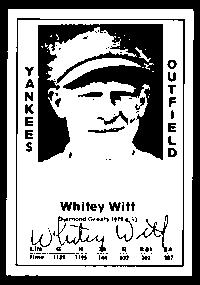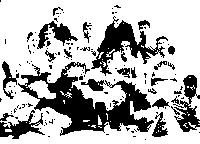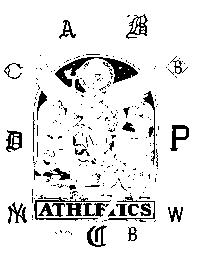In his latest column, John Cross ’76 is thinking baseball, and in particular the seven Bowdoin alumni who’ve played-or at least had a cup of coffee–in the big leagues.
Each of us has a list of favorite movies that will cause us to stop “channel-surfing” when a familiar scene appears on the television screen, regardless of the number of times that we have seen it before. For me, Field of Dreams, a baseball fantasy based on the novel Shoeless Joe by W. P. Kinsella, is one of these. One of the characters in the book and movie is Archibald “Moonlight” Graham, a real-life, well-respected, small-town doctor in Chisholm, Minnesota, who had a one-game major league baseball career with the New York Giants in 1905. Graham played two innings in the field without touching the ball, and he was next in the batting order when a teammate made the final out. Armed with an undergraduate degree from the University of North Carolina, Graham mixed minor league baseball with his medical training, leading a teammate to suggest that Graham had been “moonlighting.” According to the 2009 biography Chasing Moonlight: The True Story of ‘Field of Dreams,’ Graham continued to play town ball in Minnesota until he was in his 50s.
From what I have been able to discover, seven Bowdoin alumni played in at least one regular season game in the major leagues, and for several of them the length of their stay in “the big show” was comparable to “Moonlight” Graham’s. Of the seven, three were captains of their respective teams at Bowdoin and graduated; the other four left college early to pursue careers in professional baseball. Their lives offer a glimpse into intercollegiate athletics and the history of baseball in the first quarter of the twentieth century. In recent years, at least nine alumni were drafted or signed contracts with major league teams and played in the minor leagues; still other alumni played for semi-professional or town teams. Bowdoin alumni also may be counted among major league baseball owners, executives, physicians, trainers, and announcers, but these are stories for another time. Five Bowdoin baseball coaches (all non-alumni) reached the majors as players.
The first Bowdoin alumnus to break into major league baseball was Walter “Pop” Williams of Topsham, Maine, and the Class of 1896, who left college after three years because “his eyes began to bother him.” After coaching local high school and town teams, Williams pitched for the Toronto Canucks of the Class A Eastern League, earning him a two-game stint with the Washington Senators in 1898. After a strong season in 1902 with the Chicago Orphans (later the Cubs), he broke a finger on his pitching hand in 1903 and was traded from Chicago to the Philadelphia Phillies, and then to the Boston Beaneaters. At the end of the 1903 season he returned to Maine, continued to play semi-pro ball, and became a selectman in Topsham, a position that he held for more than 40 years.
Eddie Files, Class of 1908, of Cornish, Maine, was captain of the baseball team, class president, and a member of the Athletic Council at Bowdoin. After playing in the minors in New England, Files pitched in two games for the Philadelphia Athletics in 1908, allowing six earned runs in nine innings and going hitless in three at-bats. After playing minor league ball and coaching high school teams for two years, he became a bond salesman in Portland and served on the Alumni Council and as 1908’s Class Agent.
Leo Hafford, Class of 1909, attended Bowdoin in the 1905-06 year. A top athletic prospect from Somerville, Massachusetts, Hafford signed a contract with the Cincinnati Reds in his freshman year. Harold Seymour reports in his book, Baseball: The People’s Game, that Hafford asked the president of the Reds not to announce the signing: “The college where I am going is giving me my tuition for running and therefore I must be careful to have myself protected and also not to have the college blacklisted from its place among the other colleges.” Collegiate athletic programs were grappling with the meaning of amateur athletic status, especially when “barnstorming” exhibitions and summer baseball leagues brought professional, semi-professional, and amateur athletes together on the same field. Hafford pitched in three games for the Reds in the 1906 season, and was credited with one win and one loss. After several years of minor league ball and high school coaching, he accepted the position of head football coach at Storrs Academy in Connecticut in September of 1911, only to die three weeks later of typhoid fever.
George F. Wilson, Class of 1912, from Old Town, Maine, picked up the nickname “Squanto” before coming to Bowdoin because of his dark hair and eyes. Despite the fact that he had no discernible Native American ancestry, the name stuck. Wilson, a star football player and catcher on the baseball team, was elected captain of the baseball team in his junior year. He resigned as captain when he signed a contract with the Detroit Tigers. He played in five games with the Tigers in 1911 before an injury to his hand ended his season. He returned to Bowdoin to graduate in 1912, and continued to play minor league and semi-pro ball. He played one game at first base for the Red Sox in 1914 (no at-bats). A powerful hitter, Wilson played for minor league, semi-pro, industrial, and town teams in New England. He established the Wilson’s Dollar Stores chain in western Maine and also was a high school principal for eight years.
Born in San Diego, California, Leland McElwee, Class of 1916, was a graduate of Houlton High School in Maine. He was captain of the 1916 Bowdoin baseball team. McElwee played 54 games in the infield for the 1916 Philadelphia Athletics, and had a .265 batting average. After serving in the Navy during World War I, McElwee played three years of minor league ball in the Eastern and Texas leagues. He then embarked on a career as a public accountant, first in Boston and then for 20 years in Union and Rockland, Maine.
When Yankee Stadium opened on April 18, 1923, Witt (Class of 1919) was the first Yankee to bat in the new park, and he scored the winning run against the Red Sox in that inaugural game when Babe Ruth hit the stadium’s first home run.
One of McElwee’s rookie teammates on the 1916 Athletics had the longest and most prominent professional baseball career of any Bowdoin alumnus ““ ten seasons. Ladislaw Waldemar Wittkowski, Class of 1919, was born in Orange, Massachusetts, in 1885. By the time he arrived at Bowdoin, he was Lawton Walter Witt, a gifted and tenacious 5’7″ athlete with white-blond hair. In the spring of his freshman year he was signed to a contract with the Athletics by Hall of Fame manager Connie Mack (born Cornelius McGillicuddy), a man who recognized baseball talent and also the advantages of short surnames in preparing a lineup card. In a game against the Cleveland Indians on August 5, 1916, Witt became the first Bowdoin alumnus to hit a major league home run. An effective leadoff hitter on a bad team, “Whitey” Witt was sold to the New York Yankees in 1922. In a crucial game against the St. Louis Browns during the 1922 pennant drive, he was chasing a fly ball in center field when he was struck by a soda pop bottle hurled by an unidentified fan. Witt was knocked unconscious and suffered a deep cut to his forehead. Quick action by police prevented a riot, and the next day Whitey registered the winning hit to secure the pennant for the Yankees. When Yankee Stadium opened on April 18, 1923, Witt was the first Yankee to bat in the new park, and he scored the winning run against the Red Sox in that inaugural game when Babe Ruth hit the stadium’s first home run. A perennial figure at Yankee old-timers’ games in later years, Witt would regale sportswriters with stories of his on- and off-field adventures with Babe Ruth. He was released by the Yankees in 1926 and played for the Brooklyn Robins of the National League for a year, followed by three years of AA baseball in Kansas City, San Francisco, and Pennsylvania. When his playing days ended he operated “Whitey’s Irish Bar” in Woodstown, New Jersey, for 50 years. At the time of his death in 1988 at the age of 92 he was the last surviving Yankee from the franchise’s first world championship team.
Sid Graves ’24 of Marblehead, Massachusetts, transferred to Bowdoin from the University of New Hampshire as a sophomore, and attended the College for the 1921-22 year. On June 24, 1927, he pitched for the Lynn Papooses of the Class B New England League against the Salem Witches in the first game played by professional teams in an organized league at night under artificial light. Graves recalled that curve balls were prohibited in that game due to apprehensions about visibility and the safety of hitters. A month later he was called up to the Boston Braves, appearing in seven games as a center fielder and pinch hitter. He continued to play minor league baseball from 1928 to 1935. He retired to Kennebunk, Maine, after a long career with the U.S. Post Office in Marblehead.
Like “Moonlight” Graham, these Bowdoin major leaguers moved on to other vocations, but for the most part, baseball remained for them a passionate avocation, although it was played on a modest stage. Those who have experienced “America’s Pastime” first-hand need no elaboration of Whitey Witt’s comment at an old-timers’ game: “I don’t think very much about baseball during the day. But sometimes at night, when it’s so quiet I can hardly sleep, I can hear the crowds again.”
With Best Wishes,

John R. Cross ’76
Secretary of Development and College Relations





